|
a large prairie fire on February 24, 1876. Much hay, corn, and feed was destroyed along with small prairie animals. Great losses were felt by E. Bignell, Hugh Allen, James Welch, and D. E. Sturdevant.
"BANK OF MORSE BLUFF"
Many residents of the precinct were officers at the Bank of Morse Bluff in the 1890's. Officers in June of 1891 were: Jesse Gidley, president; Andrew Fleming, Vice-President; and J. C. Hall, cashier. Other officers from the area in later years were: J.G. Wilson, Walter Fleming, Emil E. Wolf, and C. M. Skinner.
DOUGLAS PRECINCT
SETTLEMENT
Settlement of the precinct began in early 1869. Settlers arrived from Canada, Sweden, many of the Eastern States, and other countries. The Sand Creek area of Douglas Precinct was settled early in the spring of 1869 with R. Fleming on Section 10. Others who came in the summer of 1869 were W. D. Farris, J. TePoel, Mr. Griffin, Charles Day, H. O. Connor, and later followed by Oliver Scow, Edward Scow, C. O. Scow, and James Kuypers. By the year 1870 arrived the families of John Wilcox, Lees, Simpson, Wikell, and many other pioneers.
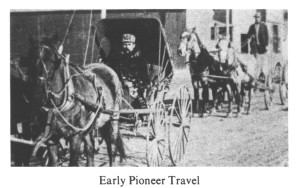 |
| Early Pioneer Travel |
The time period of 1871-1880 brought another large group of people from Canada and the Eastern States. By this time a post office, school, and church was established in the precinct. These early pioneers did travel to Fremont or Omaha to visit friends or relatives who had come earlier to settle in Nebraska. They also did their monthly shopping for groceries and supplies. Method of travel was slow but necessary.
Population reached an all-time high in Douglas precinct around 1890 due to people arriving from the Eastern States, Canada, and new births in the community. The population dropped around 1900 due to people moving westward, to people moving to other surrounding communities with land purchases, or as a result of death due to cases of influenza or old age.
Population of the precinct according to census records shows the following: Year 1880 -- population of 950; 1890 -- population of 1,208; 1900 -- population of 572; 1910 -- population of 537.
Officers within the Depression years in the Douglas Precinct in January 1929 were: Justice of the Peace -- Anton Wesley, Road Overseer -- Hans Pageler, Assessor -- J.P. Jensen.
Early pioneers of Douglas Precinct arrived from the following areas. Quite a combination of nationalities lived in the communities sharing their customs and ideas.
Fleming -- from Scotland to Canada to U.S.
Farris -- Ireland to Canada to U.S.
Gidley -- England to Canada to U.S.
Dawson -- Ireland to Canada to U.S.
Wilcox -- Scotland to Canada to U.S.
Armes -- Penn. to Nebr.
Jones -- Indiana to Nebr.
Wilson -- Ohio and Indiana to Nebr.
Whidden -- England to New Hamp. to Nebraska
Roberts -- Wales to Wisconsin to Nebr.
Wikell -- Ohio to Nebraska
TePoel -- Holland to U.S.
Ladenburger -- Germany to U.S.
Odvody -- Czech to U.S.
Lees -- England to Iowa to Nebraska
Wolfe -- Indiana to Nebr.
Krondak -- Bohemia-Austria to U.S.
McDaniel -- Georgia and South Carolina to Nebr.
Scow -- Norway to Iowa to Nebr.
Settles -- Eastern States from Court House Records
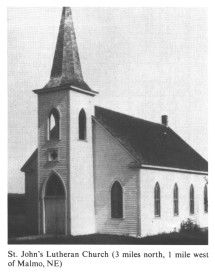 |
| St. John's Lutheran Church (3 miles north, 1 mile west of Malmo, NE) |
ST. JOHN'S AMERICAN
LUTHERAN CHURCH
A summary of the outstanding events in the church history show that it was established in 1884 by a group of German immigrants from Schleswig-Holstein and some other provinces. Some of the families first settled in Illinois and then came to Nebraska.
The church joined with the German Counsel, German Lutheran Church, with headquarters in Philadelphia. The church itself, however, dates back to 1870, the date of the first entry in the records. Services were held in the District 63 schoolhouse in
Douglas Precinct.
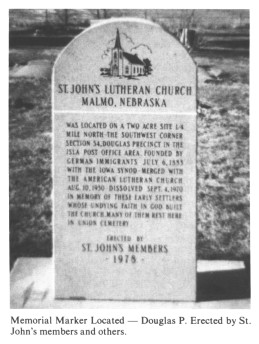 |
| Memorial Marker Located -- Douglas P. Erected by St. John's members and others. |
It was served by the Reformed Church of Clear Creek (Yutan Area), Fr. Hullhorst, pastor; H.F. Braun, also of the Reformed Church; and H. Frese of Omaha. The Reformed Church then withdrew because the major portion of the congregation did not want to leave the Lutheran Church.
Other pastors' names appearing in the early records are: J. Dibble, a Lutheran (Missouri Synod) missionary from Texas and Rev. Leuthheuser of St. Matthew's Lutheran Church near Cedar Bluffs, now in Cedar Bluffs.
In November, 1884, Rev. J. Deguisne and family came from Canada as resident pastor. They stayed at the Hans Knuth home for several weeks. He was Parisian-born and ordained in Europe. His record of the church's origin and the ten years of his ministry makes this article possible.
In March, 1888, the church separated from the General Council upon their advice and joined with the Iowa Synod. Nebraska was too far west for them to serve the church satisfactorily.
The first church was built in the early 1880's on a two-acre plot in the SW corner, Section 34, in Douglas Precinct. In 1900, a new church was built. The first building was then used for summer Bible School, confirmation classes, and the like.
Its resident pastors were: J. Deguisne, Fritz Helm, Charles Schober, Oscar Lompe, Otto Zeilinger and Cornelius Fischer, through 1927. John Hiltner then served four years, residing in Fremont and Lincoln. In 1930, the Iowa Synod merged with Ohio, the Buffalo and other States Synods to become the American Lutheran Church. Werner Heuer, Samuel Herforth, Ronald Josi, Karl Fenske, Emile Hannemann and Otto Herzog then served the congregation jointly with Zion's Lutheran Church of Ithaca and resided there.
In 1960, the UELC and the Danish ELC also merged with the ALC. Then Rev. Kloth, Ames, Nebraska served for several years. Students from the ALC College, Blair, supplied St. John's with a pastor. Dr. Thomsen of Blair was vice-pastor.
The members of the church council were without exception, directly related to the founders of the church, either as child, grandchild or great-grand-child. The remaining members were likewise so related with but a few exceptions. That relationship has without a doubt been the sustaining factor that kept the church doors open this long.
Family names appearing on the first pages of the register, 1883-1885, are: Luebker, Frahm, Dauel, Nolte Arp, Mohr, Bose, Falke, Guthardt, Knuth, Koch, Kücker, Schultz, Pageler, Holtorf, Karsch, Theede Bahm, Sievers, Müller and Lemke.
St John's Church held its last service with Holy Communion in August 1969, Dr. Thomsen, Blair officiating. The final meeting of the congregation was held in April, 1970. Dr. Madsen, the Central District, president presiding. The members present voted unanimously to dissolve the congregation
In June 1970, the church building and other properties were sold at public auction. The proceeds were donated to the Mariposa Union Cemetery Maintenance Fund. Submitted by Josephine Holtorf Jenny
SPRING CREEK CHURCH
The Spring Creek Church was established in the early 1870's. The church was built in the SE ¼ section 21-16-6 on land donated by Jesse Gidley. Originally it was a joint Presbyterian-Methodist venture to be used by each congregation on alternating Sundays. Presbyterian participation was terminated when the present Presbyterian Church was organized in Cedar Bluffs. An annual oyster stew supper is one thing that was remembered about the Spring Creek Church.
The exact date the church was closed is not known. The assets were divided equally between the Methodist churches in Morse Bluff and Cedar Bluffs. The plot of ground reverted back to the Gidley property when the church was disbanded.
The funeral of William Gidley Sr. was preached in the Spring Creek M.E. in 1897. Jesse Gidley's funeral services were also held from the church in
page 72
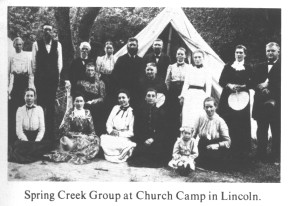 |
| Spring Creek Group at Church Camp in Lincoln. |
1920. Mrs. Jesse Gidley united with the Methodist Church and was a charter member of the church. The church was no longer in existence when Mrs. John Whidden died in 1929 as her services were held in Morse Bluff. She was the daughter of Jesse Gidley.
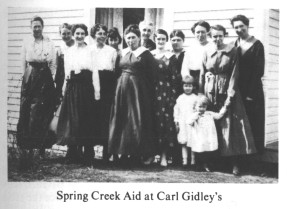 |
| Spring Creek Aid at Carl Gidley's |
SPRING CREEK LADIES AID
The Spring Creek Ladies Aid Group continued long after the M.E. Church was closed and lent their support to the Morse Bluff M.E. Church. It continued to the late 1950's and was a community social event with very few of the members belonging to the Methodist Church.
Some of the known charter members were: Mrs. David (Mag) Roberts, Mrs. Walter (Julia) Fleming, Mrs. Henry (Lottie) Wolfe, Mrs. Jesse (Sarah) Gidley, Mrs. Charles Wilcox, Mrs. John Wilson, Mrs. Frahm, Mrs. Wolfe, Mrs. Jones, Mrs. Farris, Mrs. Schuler, Mrs. Mead.
The old records of the Ladies Aid were lost in 1936 when Mrs. Ira Wolfe was secretary and they lost their home in a fire.
SAND CREEK POST OFFICE
The Sand Creek Post Office of Douglas Precinct is one of the "Old Land Marks" of Saunders County. This post office was on the Platte bottom a short distance east of where Morse Bluff is now located. It was discontinued in 1903.
This post office was begun in 1870 with Robert Fleming as postmaster. When Mr. Fleming resigned in 1884, Jesse Gidley became postmaster. Mail was carried by horseback. The route was from Lincoln to Benton. When Ashland was the county seat the route was changed and Sand Creek was supplied from there to Cedar Bluffs to Sand Creek post office. Later, when Wahoo became the county seat the route was established daily from Wahoo to North Bend through Sand Creek. Mail routes were also established from Sand Creek to Plasi by way of Prague.
FLEMING CEMETERY
Robert Fleming deeded a tract of land in Section 10-16-6 to the Sand Creek Burying Ground Association in the early 1870's. In the years that have followed it has been commonly referred to as the Fleming Cemetery.
One of the first burials was from a wagon train passing through the area. They were directed to the Fleming Cemetery. But the boundaries were not yet marked too well and the burial was made on adjoining land.
The cemetery was originally used by, but not restricted to, early Anglo-Saxon and German Protestant settlers. But this area may be the only vicinity in the county that had a black family among its early settlers and they have children buried in the cemetery.
The cemetery is unusual in that no one has ever paid for a lot. It is cared for and mowed by volunteer labor from those who have relatives buried there. Many who are unable to help in the care donate funds for improvements and maintenance. Most of the area is still covered by native prairie grass and has a very attractive appearance. Submitted by Curtis and Walter Fleming
ST. JOSEPH'S CEMETERY
St. Joseph's Cemetery is located in the NW ¼ NW ¼ of Section 25, Township 16 (Douglas) Range 6 E.
This small, rural cemetery is one of the older cemeteries in the county. Many early deaths in the cemetery were due to influenza or the blizzard of 1888. Many early deaths were found in the time period of 1879-1890. Many young children were among these deaths.
If someone was researching for information, you would find the following surnames within the cemetery: Ballard, Bartek, Blair, Booth, Bouc, Couley, Daley, Dailey, Dean, Denesia, Donnelly, Eck, Fanning, Farris, Finegan, Fishler, Fraley, Griffin, Hastings, Hayes, Higgins, Howard, Kennedy, Kirchman, Kruce, Lowry, McCoy, McDermott, McElfresh, Malloy, Mulderman, Murren, Murphy, O'Connor, O'Donnell, Plunkey, Pollard, Scott, Shanahan, Smit, Sullivan, Taugher, TePoel, Theede, Tillman, Van Driel, Ward, Warner, Weber, Wernsman, plus many new surnames since the cemetery readings were done by Clara Mares of Fremont and recorded.
Very few of these surnames are found in Douglas Precinct today. Many of these families were the early pioneers of the rural community, who settled in the late 1860's and early 1870's.
DISTRICT #79
District 79 was organized in 1923 and made up of an area between existing Districts 34 and 54. Thos. Settles, Ira Wolfe, and Walter Fleming were the original board members. A new building was constructed on a tract of land on the David Roberts farm.
District 79 school served its purpose of providing a good elementary education to the families of: Thos., Faye, and Henry Settles, Anson, Ira and Henry Wolfe, Walter and Robert Fleming, Andrew Schaver, Frank Lemke, Joe Sousek, Thos. Roberts, Adolph Cerney, John Shanahan, Ernest Ladenburger, and many others. There were generally between twenty and thirty students in the 1920's through the 1940's.
The student numbers declined in the 1950's and the district merged with District 14 in Morse Bluff in 1960. The building was moved to Morse Bluff and now serves as the American Legion Building. The school ground has reverted back to the Thos. Roberts Farm. Submitted by Curtis Fleming and his father, Walter Fleming
DISTRICT 34
District 34 started in March 1873 by a donation of an acre of land for a school site by William D. and Christina Farris. It was located in Douglas Precinct, Section 14, Township 16, Range 6.
Ole A. Day was the director and Addie Whalpen was the teacher for the opening year with 16 students. The length of the school year was 5 months.
Enrollment increased in 1899 and it was decided to build a larger school and also to move the school ½ mile south and ¼ mile east. Mr. John Wesley donated land for the school site in Section 23. A building 20 x 50 with a gable roof was built overlooking Sand Creek, from which the school got its name. There were 24 students. Mr. Adam Fleming was director and Mrs. William Wilson was the teacher.
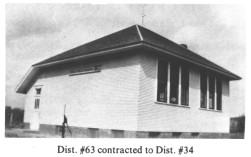 |
| Dist. #63 contracted to Dist. #34 |
On May 23, 1923, a new district #70 was started and District 34 lost much money in its valuation,
In 1953, District 63 started to contract its students to District 34. In 1959 District 63 transferred all its land and property to District 34.
In 1961 School District 79 contracted some of its students to District 34. In 1964 District 79 closed.
In 1968 and 1969 District 34 contracted its students to other districts. In 1970 the school reopened with 5 students. At the present time, 1982, there are 13 students, Mrs. James Lichtenberg is the teacher. Board members are Edward Bartek, Robert Dauel, and Larry Johnson. The old traditions of having a Christmas program and an annual school picnic every year are still followed.
DISTRICT 92
District 92 of Douglas Precinct had many families in the School Census of 1888. The school director was W.H. Easom at the time. Family names on the school census listed: Allan, Wilcox, Brush, Armes, Wilson, Callan, Bignell, Easom, Jones, Thompson, Roddy, Ballard, and Odvody. In the year of 1888 the Henry Bignell family had the largest family with 8 children. The G.B. Armes and the W.H. Easom families each had 5 children. From the year of 1888 to 1918 there were many families moving in and out of the precinct due to the war years.
District 92 continued through the years with large numbers of children attending the school each year. Many families today remember the school ground, the family picnics held there, and still keep in touch with families who had lived in that area many years ago.
In 1963, a large part of District 92 was annexed into District #51.
WINTER ENTERTAINMENT
The local neighborhoods within Douglas Precinct had Rook parties every week in the winter months in the 1920's and 1930's. Some people objected to playing cards but played Rook because the deck had no face cards. It used colors instead of spades, clubs, etc.
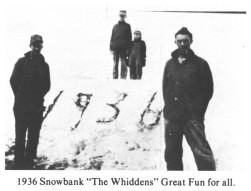 |
| 1936 Snowbank "The Whiddens" Great Fun for all. |
page 73
| 
